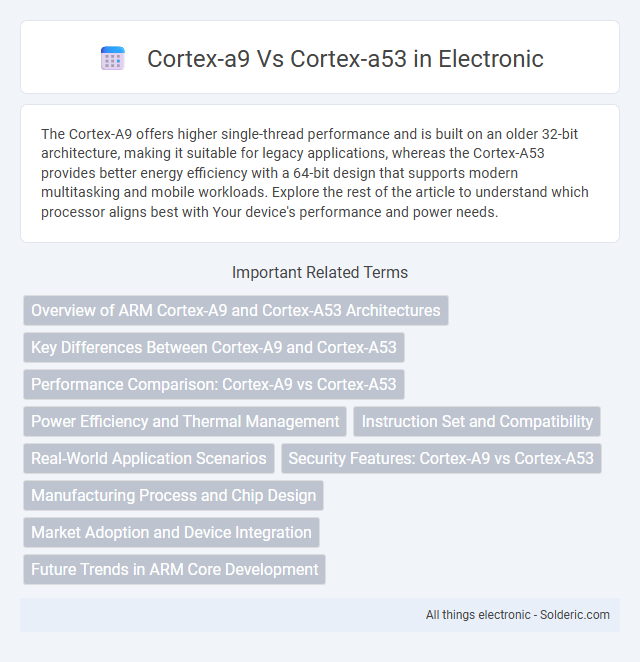The Cortex-A9 offers higher single-thread performance and is built on an older 32-bit architecture, making it suitable for legacy applications, whereas the Cortex-A53 provides better energy efficiency with a 64-bit design that supports modern multitasking and mobile workloads. Explore the rest of the article to understand which processor aligns best with Your device's performance and power needs.
Comparison Table
| Feature | Cortex-A9 | Cortex-A53 |
|---|---|---|
| Architecture | ARMv7-A (32-bit) | ARMv8-A (64-bit) |
| Release Year | 2007 | 2012 |
| Core Count | 1-4 cores | 1-8 cores |
| Performance | Up to 1.5 GHz, out-of-order execution | Up to 1.5-2.0 GHz, out-of-order execution, improved IPC |
| Power Efficiency | Moderate | High, big.LITTLE support |
| Instruction Set | ARMv7 (32-bit), NEON SIMD | ARMv8 (64-bit), NEON SIMD, Cryptography extensions |
| Cache | L1: 32KB I/D, L2: Up to 4MB shared | L1: 32KB I/D, L2: Up to 2MB shared |
| Use Cases | Smartphones (2010s), embedded systems | Mid-range smartphones, IoT devices, entry-level servers |
Overview of ARM Cortex-A9 and Cortex-A53 Architectures
ARM Cortex-A9, based on ARMv7-A architecture, delivers high-performance with a dual- or quad-core design optimized for multimedia and mobile applications, utilizing out-of-order execution and NEON SIMD for efficient processing. The Cortex-A53, built on ARMv8-A architecture, offers a 64-bit capable design with improved energy efficiency and security features, supporting big.LITTLE configurations for balanced performance and power consumption. You benefit from the Cortex-A53's advanced scalability and longer battery life in modern smartphones, while Cortex-A9 suits legacy devices requiring robust 32-bit processing.
Key Differences Between Cortex-A9 and Cortex-A53
The Cortex-A9 is a 32-bit processor based on ARMv7 architecture, emphasizing high performance and power efficiency for earlier mobile and embedded devices. The Cortex-A53 supports 64-bit ARMv8 architecture, offering enhanced processing power, improved energy efficiency, and better support for modern applications through features like ARM TrustZone and advanced SIMD instructions. Performance-wise, the Cortex-A53 excels in multi-core configurations and modern software compatibility, while the Cortex-A9 remains suitable for legacy systems requiring efficient 32-bit processing.
Performance Comparison: Cortex-A9 vs Cortex-A53
The Cortex-A9, built on older ARMv7 architecture, delivers strong single-thread performance with clock speeds up to 2.0 GHz but lacks the energy efficiency of the newer Cortex-A53, which features ARMv8 64-bit architecture and improved power management. The Cortex-A53 excels in multi-core scalability and supports modern instruction sets, making it more suitable for contemporary mobile and embedded applications where balanced performance and battery life are critical. Your choice depends on whether raw per-core speed (Cortex-A9) or efficient 64-bit processing with better thermal performance (Cortex-A53) aligns with your device's requirements.
Power Efficiency and Thermal Management
The Cortex-A53 delivers superior power efficiency due to its 64-bit architecture and ARMv8 design, enabling lower power consumption and extended battery life compared to the Cortex-A9's older 32-bit ARMv7 architecture. Its advanced thermal management reduces heat generation, allowing your device to maintain optimal performance during prolonged use. The Cortex-A9, while powerful, tends to produce higher heat and consume more energy, making the Cortex-A53 a preferred choice for energy-conscious applications.
Instruction Set and Compatibility
The Cortex-A9 utilizes the ARMv7-A instruction set, supporting both 32-bit processing and ARM's Thumb-2 technology, making it compatible with many legacy and modern 32-bit applications. In contrast, the Cortex-A53 employs the ARMv8-A architecture, offering native 64-bit processing alongside backward-compatible 32-bit support, enhancing performance and future-proofing your device. This difference in instruction set architecture means the Cortex-A53 provides broader software compatibility and improved efficiency for newer operating systems and applications.
Real-World Application Scenarios
The Cortex-A9 excels in performance-intensive tasks like gaming and multimedia streaming thanks to its out-of-order execution and higher clock speeds, making it ideal for older flagship devices. The Cortex-A53, designed with energy efficiency and 64-bit support, suits modern smartphones, tablets, and IoT devices requiring balanced power consumption and adequate processing power. Your choice between the two should consider whether raw performance or power efficiency is the priority for your application.
Security Features: Cortex-A9 vs Cortex-A53
The Cortex-A53 incorporates TrustZone technology, enabling hardware-based security for trusted execution environments, whereas the Cortex-A9 lacks this feature. Secure boot and hardware virtualization support in the Cortex-A53 provide enhanced protection against unauthorized access, which the Cortex-A9 does not natively support. Cryptographic acceleration and improved secure debug capabilities further distinguish the Cortex-A53 as a more security-focused architecture compared to the Cortex-A9.
Manufacturing Process and Chip Design
The Cortex-A53 is built using a more advanced 28nm or 16nm FinFET manufacturing process compared to the Cortex-A9's older 40nm planar technology, leading to better power efficiency and performance scaling. Chip design-wise, the Cortex-A53 features a 64-bit ARMv8 architecture with a simpler, energy-efficient in-order pipeline, whereas the Cortex-A9 is based on a 32-bit ARMv7 architecture with a more complex out-of-order pipeline. This difference in process technology and architecture enables the Cortex-A53 to deliver improved energy efficiency and multicore scalability suitable for modern mobile and embedded applications.
Market Adoption and Device Integration
The Cortex-A53 has seen broader market adoption due to its balance of energy efficiency and 64-bit support, making it a preferred choice for mid-range smartphones, IoT devices, and entry-level laptops. The Cortex-A9, while popular in earlier high-performance devices and embedded systems, has been largely superseded by newer architectures in mainstream consumer electronics due to its 32-bit design and lower energy efficiency. Device integration trends highlight the Cortex-A53's dominance in system-on-chip (SoC) designs by major manufacturers like Qualcomm and MediaTek, enabling scalable solutions across diverse product categories.
Future Trends in ARM Core Development
Cortex-A53 excels in energy efficiency and 64-bit processing, making it a staple in mid-range devices, while Cortex-A9, although older, offers strong performance in 32-bit applications. Future trends in ARM core development prioritize heterogeneous computing, integrating big.LITTLE architectures to balance power and performance. Your choice of ARM core will influence device longevity as newer cores increasingly focus on AI acceleration and improved security features.
cortex-a9 vs cortex-a53 Infographic

 solderic.com
solderic.com